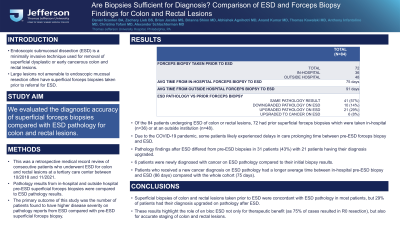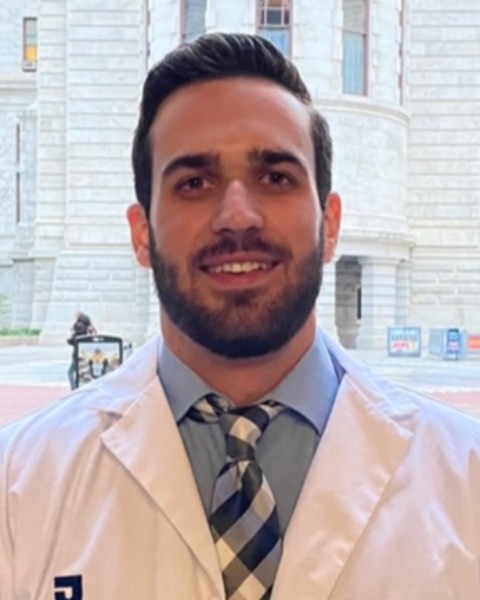Back


Poster Session E - Tuesday Afternoon
Category: Colon
E0085 - Are Biopsies Sufficient for Diagnosis? Comparison of ESD and Forceps Biopsy Findings for Colon and Rectal Lesions
Tuesday, October 25, 2022
3:00 PM – 5:00 PM ET
Location: Crown Ballroom

Has Audio

Daniel Scanlon, BA
Thomas Jefferson University Hospital
Philadelphia, PA
Presenting Author(s)
Daniel Scanlon, BA1, Zachary Lieb, BS1, Brian Jacobs, BA2, Brianna Shinn, MD1, Abhishek Agnihotri, MD1, Anand Kumar, MD, MPH3, Thomas Kowalski, MD1, Anthony Infantolino, MD1, Christina Tofani, MD1, Alexander Schlachterman, MD1
1Thomas Jefferson University Hospital, Philadelphia, PA; 2Thomas Jefferson University Hospital, New Brunswick, NJ; 3Thomas Jefferson University, Philadelphia, PA
Introduction: Endoscopic submucosal dissection (ESD) is a minimally invasive technique used for removal of superficial dysplastic or early cancerous colon and rectal lesions. For larger lesions ( >20mm) that are not amenable to endoscopic mucosal resection, superficial biopsies are typically taken prior to referral for ESD. The aim of this study was to evaluate the degree of concordance between superficial forceps biopsies and ESD pathology.
Methods: A retrospective medical record review was performed including consecutive patients who underwent ESD of colon and rectal lesions at a tertiary care center between 10/2018 and 11/2021. Pathology results from outside hospital and same institution pre-ESD superficial forceps biopsies were compared to ESD pathology results. The primary outcome was the number of patients found to have higher disease severity on ESD pathology compared with superficial forceps biopsies.
Results: Of the 84 patients who underwent ESD of colon or rectal lesions, 72 had pre-ESD superficial forceps biopsies which were taken at an outside hospital (n=48) or at the same institution (n=36). The average length of time between outside hospital superficial forceps biopsies and ESD was 91 days compared to 75 days for those performed at the same institution. Delays between superficial forceps biopsies and ESD may be related to the COVID-19 pandemic prolonging time between procedures. Pathology findings after ESD differed from superficial forceps biopsies in 31/72 patients (43%) with 21 patients receiving upgraded disease severity and 6 patients receiving a new cancer diagnosis based on ESD pathology. Patients who received a new cancer diagnosis had more days between superficial forceps biopsies and ESD compared with the whole cohort (86 vs 75, respectively).
Discussion: While superficial forceps biopsies of colon and rectal lesions were typically concordant with ESD pathology, 29% of patients in this cohort received upgraded disease severity based on ESD pathology. This shows that while superficial forceps biopsies can aid in diagnosis, en bloc resection via ESD remains critical for accurate diagnosis of large colon and rectal lesions. These results also show that ESD is not only diagnostic but therapeutic given 75% of the patients in this cohort achieved R0 resection.
Disclosures:
Daniel Scanlon, BA1, Zachary Lieb, BS1, Brian Jacobs, BA2, Brianna Shinn, MD1, Abhishek Agnihotri, MD1, Anand Kumar, MD, MPH3, Thomas Kowalski, MD1, Anthony Infantolino, MD1, Christina Tofani, MD1, Alexander Schlachterman, MD1. E0085 - Are Biopsies Sufficient for Diagnosis? Comparison of ESD and Forceps Biopsy Findings for Colon and Rectal Lesions, ACG 2022 Annual Scientific Meeting Abstracts. Charlotte, NC: American College of Gastroenterology.
1Thomas Jefferson University Hospital, Philadelphia, PA; 2Thomas Jefferson University Hospital, New Brunswick, NJ; 3Thomas Jefferson University, Philadelphia, PA
Introduction: Endoscopic submucosal dissection (ESD) is a minimally invasive technique used for removal of superficial dysplastic or early cancerous colon and rectal lesions. For larger lesions ( >20mm) that are not amenable to endoscopic mucosal resection, superficial biopsies are typically taken prior to referral for ESD. The aim of this study was to evaluate the degree of concordance between superficial forceps biopsies and ESD pathology.
Methods: A retrospective medical record review was performed including consecutive patients who underwent ESD of colon and rectal lesions at a tertiary care center between 10/2018 and 11/2021. Pathology results from outside hospital and same institution pre-ESD superficial forceps biopsies were compared to ESD pathology results. The primary outcome was the number of patients found to have higher disease severity on ESD pathology compared with superficial forceps biopsies.
Results: Of the 84 patients who underwent ESD of colon or rectal lesions, 72 had pre-ESD superficial forceps biopsies which were taken at an outside hospital (n=48) or at the same institution (n=36). The average length of time between outside hospital superficial forceps biopsies and ESD was 91 days compared to 75 days for those performed at the same institution. Delays between superficial forceps biopsies and ESD may be related to the COVID-19 pandemic prolonging time between procedures. Pathology findings after ESD differed from superficial forceps biopsies in 31/72 patients (43%) with 21 patients receiving upgraded disease severity and 6 patients receiving a new cancer diagnosis based on ESD pathology. Patients who received a new cancer diagnosis had more days between superficial forceps biopsies and ESD compared with the whole cohort (86 vs 75, respectively).
Discussion: While superficial forceps biopsies of colon and rectal lesions were typically concordant with ESD pathology, 29% of patients in this cohort received upgraded disease severity based on ESD pathology. This shows that while superficial forceps biopsies can aid in diagnosis, en bloc resection via ESD remains critical for accurate diagnosis of large colon and rectal lesions. These results also show that ESD is not only diagnostic but therapeutic given 75% of the patients in this cohort achieved R0 resection.
Disclosures:
Daniel Scanlon indicated no relevant financial relationships.
Zachary Lieb indicated no relevant financial relationships.
Brian Jacobs indicated no relevant financial relationships.
Brianna Shinn indicated no relevant financial relationships.
Abhishek Agnihotri indicated no relevant financial relationships.
Anand Kumar: Olympus – Consultant.
Thomas Kowalski: Boston Scientific – Consultant. Olympus – Consultant.
Anthony Infantolino indicated no relevant financial relationships.
Christina Tofani indicated no relevant financial relationships.
Alexander Schlachterman: Boston Scientific – Consultant. FujiFilm – Consultant. Lumendi – Consultant. Medtronic – Consultant. Olympus – Consultant.
Daniel Scanlon, BA1, Zachary Lieb, BS1, Brian Jacobs, BA2, Brianna Shinn, MD1, Abhishek Agnihotri, MD1, Anand Kumar, MD, MPH3, Thomas Kowalski, MD1, Anthony Infantolino, MD1, Christina Tofani, MD1, Alexander Schlachterman, MD1. E0085 - Are Biopsies Sufficient for Diagnosis? Comparison of ESD and Forceps Biopsy Findings for Colon and Rectal Lesions, ACG 2022 Annual Scientific Meeting Abstracts. Charlotte, NC: American College of Gastroenterology.
